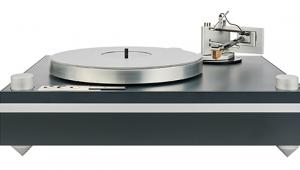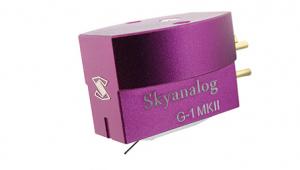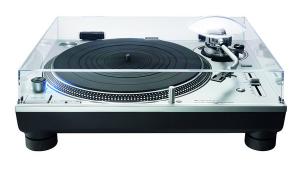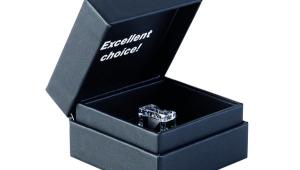Clearaudio Performance 'black Pearl' (£2300)
Only a fool – in these harsh times – would suggest that £2300 for a complete analogue package is a budget outlay. But judged in context, that amount spent on Clearaudio’s Performance turntable, Satisfy Carbon Directwire arm and Maestro Wood moving-magnet cartridge seems like a gift. After all, the tonearm on its own costs £870, while the cartridge sells for £645. Thus the Performance – sold only with the arm and cartridge – accounts for a mere £785 of the total package price. That’s an awful lot of deck for the money.
Available in ‘a rather nice “MacBook” style white’ or the sexy ‘Black Pearl’ reviewed here, the deck is a compact and elegant player with a footprint of only 420x330mm. Fashioned from high density fibreboard in an aluminium frame, sandwiched between two layers of ‘Staron’ artificial stone, the chassis’ materials and construction were chosen for their ability to control resonance. It rests on three feet, it’s superbly finished and it’s as simple as a deck can be.
A cut-out in the rear-left corner serves as a locator for the outboard motor/pulley, which also carries the on/off switch, but it suffers from the usual vague instructions about how to place it to the millimetre. Drive is via a joint-less silicon-based belt to the machined 40mm-thick acrylic platter. My solution is to check everything with a strobe disc, and if there’s no drifting or speed inaccuracy, stop worrying about it.
That platter slides over a spindle resting on Clearaudio’s new Ceramic Magnetic Bearing, employed for the first time in the Performance. The bearing shaft is machined from ‘an exclusive new ceramic alloy’, said to produce a much finer polished surface than previously obtainable. Because there is neither a ball bearing nor a thrust pad, Clearaudio believes that its new bearing avoids any ‘point of load’, thus eliminating bearing friction, wear and noise.
Tracing the groove is the Maestro Wood from the top end of Clearaudio’s MM selection, and it loved the 47kohm setting of my Audio Research PH5 phono stage. It’s carried by the Satisfy Carbon Directwire, with magnetic bias compensation, twin-axis sapphire and ceramic bearings and woven carbon-fibre arm tube. The arm’s name refers to an unbroken length of Clearaudio’s Direct Wire from cartridge to phono plugs.
MASSIVE ATTACK
No messing around: the first notes from Mobile Fidelity’s reissue of Marvin Gaye’s Let’s Get It On possessed mass, form and fluidity that perfectly complemented the prodigious – in terms of both quality and quantity – bass of the Wilson Sophia 2 loudspeakers [see HFN, May ’09]. Plenty of snap where needed, palpable textures, richness of the analogue era, the system’s lower octaves made me wish I had Kodo drums on vinyl rather than CD, just to see if it could hang together.
Gaye’s voice, though, rendered all else as secondary. The Maestro, carried with grace by the Satisfy, did a hell of an impression of one of Clearaudio’s much dearer MCs. I’m not saying you can ditch your Goldfinger, which offers much more detail, finesse and impact, but this cartridge at a tenth of the price has much of the warmth and most of the space I expect of a great MC. The vocals, more than any other sounds emanating from the system, were the source of numerous wow!-but-that-sounds-real moments.
Admittedly, the Gaye title is a super-quiet, ultra-high quality pressing, so I turned to conventional releases to hear how the package resolved groove whoosh, tracing noise and other possible ills. With a clean, original mono pressing of Connie Francis Sings Jewish Favorites, the clarity and detail were such that you had to admire her command of a decent Yiddish accent. Her re-working of ‘My Yiddishe Momme’ had me on the phone to the USA, while ‘Anniversary Song’ capped the day I celebrated my 31st. Oy, did it sound modern, despite its release date of 1960 and God knows how many plays. The Maestro/Satisfy buried the noise – if there was any to bury.
Out of fairness to Ms Francis, I followed it with Connie Francis Sings Modern Italian Hits, appropriate as she is Italian. Following the Jewish album by two years, it shares the MGM sound of the era, her perfectly-captured vocals veering from crystalline to liquid, the Maestro swinging from texture to texture, tone to tone. ‘Al Di La’ has never sounded so vibrant. And as Ms Francis was known for the sort of enunciation now out of fashion, it was a most musical way to polish one’s Italian.
SWITCHING TO STEREO
But both LPs were mono, and – beyond demonstrating that the Clearaudio presents a rock-solid centre image – I had to relish some stereo. Reverting to an old favourite, Poco’s Pickin’ Up The Pieces, the opening walk-across-the-soundstage exploited all three dimensions, as did the dubbed-into-the-background guitar work on ‘Sad Memory’, from Buffalo Springfield’s Again. Reminding myself of sage advice from Arnie Nudell, then of Infinity, one can attribute much to correct soundstage recreation, the success of which requires accuracy, retrieval of low-level details, spot-on directionality, dispersion, ad infinitum. In other words, if the imaging is right, then the tonality must be, too.
In this respect, the Clearaudio ignores any price constraints. It also behaves like a dearer model for transient attack and decay, but it’s softer and less imposing than, say, an SME 30, or its floorstanding siblings. But they cost a whole lot more.
VERDICT
Value for money – check. Great looks and build quality – check. Ease of use – check. Simple set-up – check. Delightful sound – check. Clearaudio ticks all the boxes with this package, a wise upgrade for those moving from £300-£1000 entry-level offerings to decks, arm and cartridges worthy of a high-end amp and speakers. Big-sounding, warm and controlled – buy with confidence.
This review was originally published in the June 2009 issue

























































